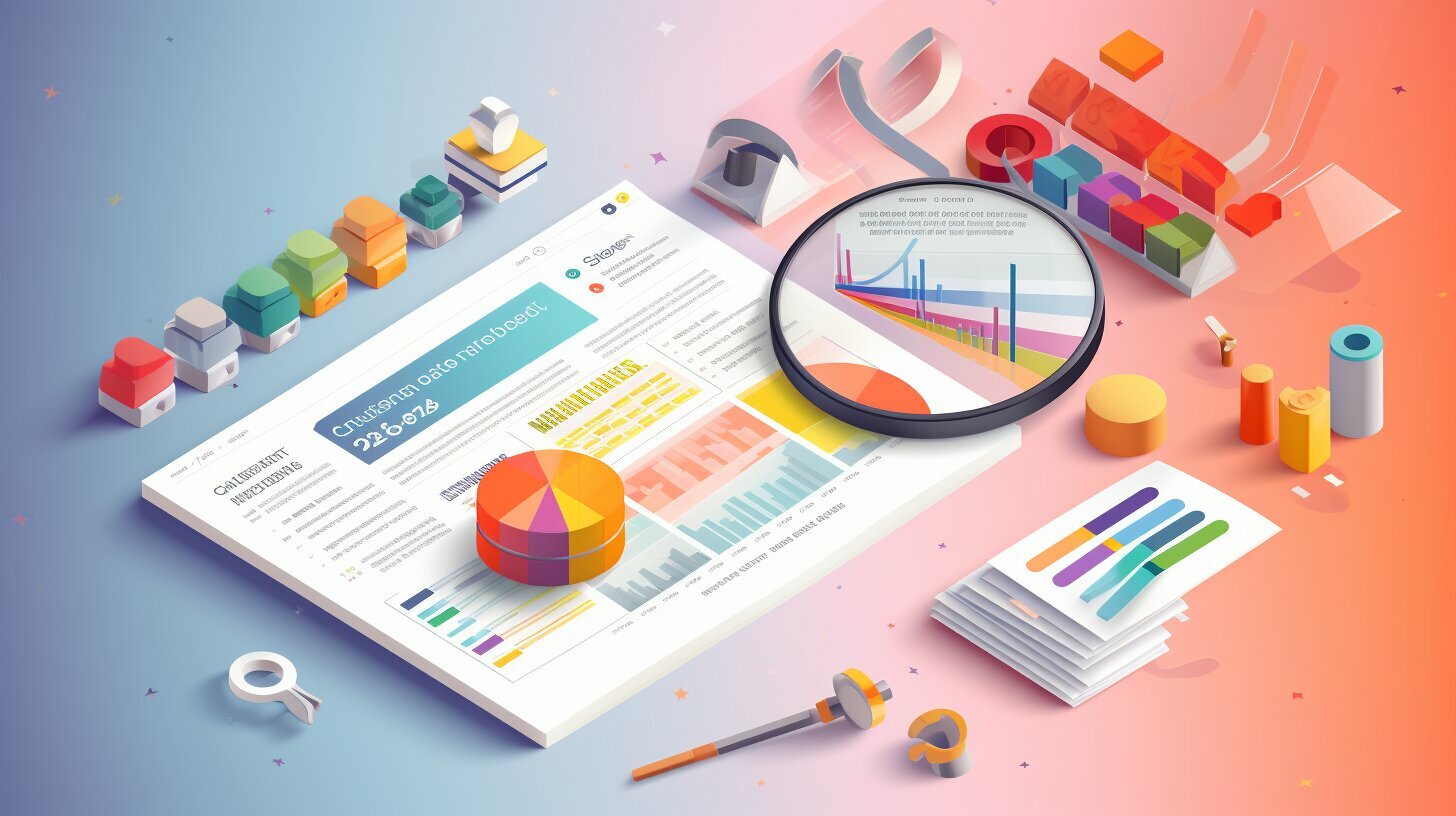Calculating the return on investment (ROI) for digital marketing campaigns is crucial for businesses to gauge their success. By determining the ROI, businesses can measure the effectiveness of their digital marketing efforts and make informed decisions to optimize their campaigns.
To calculate ROI for digital marketing campaigns, it is essential to consider the net profit generated from these campaigns and compare it to the total cost of the campaigns. The ROI is then calculated by dividing the net profit by the total cost and multiplying it by 100 to express it as a percentage.
Key Takeaways:
- Calculating ROI for digital marketing campaigns is vital for measuring success and making informed decisions.
- ROI can be calculated by dividing the net profit from the campaigns by the total cost and multiplying it by 100.
- Strategies to improve ROI include targeting the right audience and optimizing campaigns for maximum impact.
- Tracking and analyzing campaign performance through metrics like click-through rates and conversion rates is crucial.
- Tools like Google Analytics can help businesses track and measure digital marketing ROI effectively.
Why Calculating ROI is Important for Digital Marketing Campaigns
Measuring ROI for online marketing campaigns is vital for businesses to assess the performance of their digital campaigns. Calculating ROI allows businesses to determine the effectiveness and profitability of their marketing efforts, providing valuable insights for decision-making and future planning.
By calculating ROI, businesses can understand the return they are getting on their investment in digital marketing. This information helps in allocating resources and budget more effectively, ensuring that marketing efforts are focused on strategies that deliver the highest returns.
ROI calculation methods enable businesses to track the success of their digital campaigns and measure the impact on key performance indicators. It helps businesses identify which campaigns are generating the most revenue and optimize their strategies accordingly.
Measuring ROI for Online Marketing
When measuring ROI for online marketing, businesses should consider both financial and non-financial metrics. Financial metrics include revenue generated, sales, and cost per acquisition. Non-financial metrics, such as brand awareness, customer engagement, and social media reach, provide valuable insights into the overall impact of the campaigns.
| Financial Metrics | Non-Financial Metrics |
|---|---|
| Revenue generated | Brand awareness |
| Sales | Customer engagement |
| Cost per acquisition | Social media reach |
By analyzing both financial and non-financial metrics, businesses can gain a holistic view of their digital marketing performance and make data-driven decisions for future campaigns.
The Calculation Method for ROI in Digital Marketing
The calculation method for ROI in digital marketing campaigns involves using an ROI calculator and tracking campaign return on investment. This allows businesses to measure the effectiveness of their digital marketing efforts and make data-driven decisions for future campaigns.
An ROI calculator is a valuable tool that helps businesses determine the return on investment for their digital marketing campaigns. The calculator takes into account the net profit generated from the campaigns and compares it to the total cost of the campaigns. By dividing the net profit by the total cost and multiplying it by 100, businesses can calculate their ROI percentage.
To accurately track campaign return on investment, businesses should implement robust tracking and measurement systems. These systems can provide insights into key performance metrics such as click-through rates and conversion rates. By analyzing these metrics, businesses can identify which campaigns are generating the highest returns and optimize them accordingly.
| Benefits of ROI Calculation in Digital Marketing |
|---|
| Helps businesses measure the effectiveness of their digital marketing efforts. |
| Enables data-driven decision making for future campaigns. |
| Identifies high-performing campaigns for optimization. |
By leveraging an ROI calculator and tracking campaign return on investment, businesses can gain valuable insights into their digital marketing performance. This allows them to allocate resources effectively, optimize campaigns for maximum impact, and ultimately achieve higher returns on their marketing investments.
Strategies to Improve ROI in Digital Marketing Campaigns
Improving ROI in digital marketing campaigns requires analyzing digital advertising ROI and optimizing campaigns for maximum impact. By carefully assessing the performance of your campaigns, you can identify areas for improvement and make data-driven decisions to drive better results. Here are some strategies that businesses can implement to increase their ROI:
- Target the Right Audience: One of the key factors in improving ROI is ensuring that your campaigns are reaching the right audience. By conducting thorough market research and utilizing advanced targeting techniques, you can focus your efforts on the most relevant and valuable segments of your target market.
- Create Compelling and Relevant Content: In order to optimize campaigns for maximum impact, it is crucial to deliver compelling and relevant content to your audience. By understanding their needs, pain points, and desires, you can tailor your messaging and creative assets to resonate with them, increasing engagement and conversion rates.
- Test and Optimize: Continuous testing and optimization are essential for improving ROI in digital marketing. By leveraging data and analytics, you can identify underperforming elements of your campaigns and make data-driven adjustments to improve results. This can include testing different ad formats, headlines, calls to action, and landing pages.
Maximizing ROI through Effective Campaign Optimization
When it comes to optimizing your campaigns for maximum impact, it is important to consider both the pre-campaign and in-campaign stages. Pre-campaign optimization involves conducting thorough research and planning, including audience segmentation, competitive analysis, and setting campaign objectives. In-campaign optimization, on the other hand, focuses on monitoring and adjusting your campaigns in real-time, based on the data and insights you gather.
“Optimizing campaigns for maximum impact requires a holistic approach that encompasses both the strategic planning phase and the ongoing optimization process. By constantly monitoring performance, testing new strategies, and making data-driven adjustments, you can ensure that your campaigns are delivering the best possible results.”
By implementing these strategies, businesses can increase their ROI in digital marketing campaigns and maximize their return on investment. However, it is important to note that every business is unique, and what works for one may not work for another. Therefore, it is crucial to continually evaluate and adapt your strategies based on your specific goals, target audience, and industry dynamics.
| Strategy | Description |
|---|---|
| Target the Right Audience | Conduct market research and utilize advanced targeting techniques to reach the most relevant audience. |
| Create Compelling and Relevant Content | Deliver content that resonates with your audience’s needs, pain points, and desires. |
| Test and Optimize | Continuously test and optimize your campaigns based on data and analytics. |
Tracking and Analyzing Campaign Performance
Tracking and analyzing campaign performance through metrics like click-through rates and conversion rates is essential in digital marketing. These metrics provide valuable insights into the effectiveness of marketing campaigns, allowing businesses to make data-driven decisions and optimize their strategies for maximum impact.
Click-through rates (CTR) measure the percentage of users who click on a specific link or advertisement, indicating the level of engagement and interest generated by the campaign. A high CTR suggests that the campaign is effectively capturing the attention of the target audience and driving traffic to the desired destination.
Conversion rates measure the percentage of users who take a desired action, such as making a purchase or filling out a form, after clicking on a campaign. This metric directly reflects the campaign’s ability to convert leads into customers and drive revenue. Analyzing conversion rates can help businesses identify areas of improvement and refine their marketing strategies to increase conversions.
Google Analytics: A Powerful Tool for Campaign Performance Tracking
Google Analytics is a widely used tool that provides in-depth insights into website and campaign performance. It allows businesses to track various metrics, including click-through rates and conversion rates, and gain a comprehensive understanding of their audience’s behavior and preferences.
| Metric | Definition |
|---|---|
| Click-through Rate (CTR) | The percentage of users who click on a specific link or advertisement. |
| Conversion Rate | The percentage of users who complete a desired action, such as making a purchase or filling out a form. |
“Analytics is the compass that guides digital marketing strategies. By closely monitoring click-through rates and conversion rates, businesses can uncover valuable insights that drive success and maximize ROI.”
With Google Analytics, businesses can analyze click-through rates and conversion rates across different channels, campaigns, and user segments. This data enables them to identify high-performing campaigns and optimize underperforming ones, ensuring that their marketing efforts are focused on strategies that deliver the best results.
- Track and analyze click-through rates and conversion rates to gauge campaign effectiveness.
- Utilize Google Analytics to gain comprehensive insights into audience behavior and preferences.
- Optimize campaigns based on data-driven decisions to maximize ROI.
By continuously tracking and analyzing campaign performance through metrics like click-through rates and conversion rates, businesses can make informed decisions and drive the success of their digital marketing efforts.
References:
Key Aspects to Consider in ROI Measurement
Measuring ROI in digital marketing campaigns requires considering various aspects such as mobile, search, display/video, email, and social media marketing. Each of these aspects plays a vital role in determining the success and effectiveness of a campaign.
| Aspect | Description |
|---|---|
| Mobile Marketing | With the increasing use of mobile devices, optimizing campaigns for mobile platforms is essential. This includes ensuring responsive design, fast loading times, and seamless user experience on smartphones and tablets. |
| Search Marketing | Search engine optimization (SEO) and pay-per-click (PPC) advertising are key components of search marketing. Optimizing campaigns to appear prominently in search engine results and targeting relevant keywords is crucial for driving organic traffic and achieving high ROI. |
| Display/Video Marketing | Utilizing visually appealing and engaging display and video ads can capture audience attention and drive brand awareness. Tracking metrics such as viewability, completion rates, and engagement can provide insights into the effectiveness of these campaigns. |
| Email Marketing | Email marketing remains a powerful tool for driving customer engagement and conversions. Personalization, timely delivery, and analyzing metrics such as open rates and click-through rates are essential for measuring the success of email campaigns. |
| Social Media Marketing | Social media platforms offer significant opportunities for businesses to reach and engage their target audience. Metrics such as engagement rates, follower growth, and conversions can help gauge the ROI of social media campaigns. |
By considering each of these aspects in ROI measurement, businesses can gain a comprehensive understanding of the effectiveness of their digital marketing efforts. Analyzing the performance of campaigns across these different channels can provide valuable insights and inform data-driven decision making for future strategies.
Conclusion
Measuring ROI in digital marketing campaigns is a multifaceted process that requires careful consideration of various aspects such as mobile, search, display/video, email, and social media marketing. By employing strategies tailored to each of these aspects, businesses can optimize their campaigns, improve ROI, and drive successful outcomes.
The Role of Personalization and Timely Delivery in Email Marketing
Personalization and timely delivery play a crucial role in maximizing email marketing ROI. When it comes to email campaigns, generic and mass-sent messages often fail to engage recipients and deliver the desired results. By personalizing emails based on customer data and preferences, businesses can create a more tailored and relevant experience for their audience.
One effective strategy is to segment email lists based on demographics, purchase history, or engagement level. This allows marketers to send targeted messages that resonate with specific groups of recipients. Personalization goes beyond simply addressing recipients by name; it involves customizing the content, offers, and recommendations to match each recipient’s interests and needs. By doing so, businesses can increase open rates, click-through rates, and ultimately, conversions.
In addition to personalization, timely delivery is another critical factor in email marketing success. Timing plays a significant role in the effectiveness of email campaigns. By analyzing data and understanding customer behavior, businesses can determine the optimal times to send emails for maximum impact. Sending messages at the right moment ensures they are seen when recipients are most likely to engage and take the desired action, whether it’s making a purchase, signing up for a webinar, or downloading a resource.
By investing in personalization and paying attention to timely delivery, businesses can enhance the performance of their email marketing campaigns, increasing ROI and fostering stronger connections with their audience.
Measuring Social Media Campaigns with Conversion Goals and Monetary Value
Measuring social media campaigns’ ROI requires setting conversion goals and assigning monetary value to social media activities. By establishing clear objectives and attaching specific values to actions such as clicks, leads, or purchases, businesses can accurately measure the impact of their social media campaigns. This data-driven approach enables organizations to evaluate the success of their marketing efforts and make informed decisions for future campaigns.
One effective method for measuring social media ROI is to create a conversion funnel that tracks the journey of a user from initial engagement to the desired action. By assigning a monetary value to each step in the funnel, businesses can attribute revenue generated directly from social media activities. This allows for a more comprehensive understanding of the return on investment and helps identify areas for improvement.
Furthermore, leveraging the power of data analytics tools such as Google Analytics can provide invaluable insights into the performance of social media campaigns. With the ability to track metrics like click-through rates, conversion rates, and audience demographics, businesses gain a deeper understanding of their target audience and can optimize their strategies accordingly. These tools enable organizations to continuously monitor and analyze the effectiveness of their social media campaigns, ensuring maximum impact and ROI.
| Social Media Platform | Conversion Goals | Monetary Value |
|---|---|---|
| Clicks, page likes, form submissions | $1 per click, $5 per page like, $10 per form submission | |
| Link clicks, followers, purchases | $2 per link click, $3 per follower, $20 per purchase | |
| Retweets, mentions, website visits | $0.50 per retweet, $1 per mention, $2 per website visit |
In conclusion, measuring social media campaigns’ ROI involves setting conversion goals and assigning monetary value to social media activities. By implementing a data-driven approach and utilizing tools like Google Analytics, businesses can gain valuable insights and optimize their strategies for maximum impact. When armed with accurate and comprehensive data, organizations can make informed decisions to enhance their social media campaigns and drive better results.
Leveraging ROI Data for Informed Decision Making
Leveraging ROI data is crucial for making informed decisions and shaping effective digital marketing strategies. By analyzing the return on investment from various campaigns, businesses can gain valuable insights into the performance of their marketing efforts and identify areas for improvement. This data-driven approach allows businesses to allocate resources more efficiently and optimize their digital marketing strategies to achieve maximum impact.
One important aspect of leveraging ROI data is conducting thorough ROI analysis. This involves tracking and measuring the net profit generated from each campaign and comparing it to the total cost incurred. By analyzing this data, businesses can identify which campaigns are delivering the highest returns and allocate their budget accordingly. ROI analysis also allows businesses to identify underperforming campaigns and make necessary adjustments to improve their effectiveness.
Another key aspect of leveraging ROI data is its role in shaping the overall digital marketing strategy. By understanding which campaigns are delivering the best ROI, businesses can make informed decisions on where to allocate their resources. This could involve investing more in campaigns that have shown high ROI or reallocating resources from underperforming campaigns to ones with greater potential. With ROI data as a guide, businesses can ensure that their digital marketing strategy is aligned with their goals and maximize their return on investment.
| Benefits of Leveraging ROI Data | How it Helps in Decision Making |
|---|---|
| Identify high-performing campaigns | Allocate resources to campaigns with high ROI |
| Optimize marketing efforts | Make data-driven adjustments for better results |
| Maximize return on investment | Ensure resources are allocated effectively |
Key Takeaways:
- ROI data is essential for making informed decisions and shaping effective digital marketing strategies.
- Thorough ROI analysis helps identify high-performing campaigns and optimize marketing efforts.
- Leveraging ROI data guides resource allocation and maximizes return on investment.
By leveraging ROI data, businesses can gain a deeper understanding of their digital marketing campaigns and make data-driven decisions that lead to better results. The ability to track, analyze, and optimize ROI is crucial in today’s digital landscape, where every marketing dollar counts. With the right tools and strategies in place, businesses can proactively shape their digital marketing efforts and achieve greater success.
Best Practices for ROI Calculation in Digital Marketing
Accurate ROI calculation in digital marketing campaigns requires following best practices and ensuring reliable data collection. By adopting these practices, businesses can make informed decisions and optimize their campaigns for maximum impact. Here are some key best practices to consider:
- Define clear objectives: Before embarking on a digital marketing campaign, it is important to define clear objectives and goals. This will help in identifying the metrics that need to be tracked and measured to calculate ROI accurately.
- Track all expenses: To calculate ROI, it is crucial to track and record all expenses associated with the marketing campaign. This includes not only the direct costs such as advertising spend and content creation but also indirect costs like software subscriptions and staff hours.
- Implement reliable tracking tools: Reliable tracking tools like Google Analytics play a vital role in accurately measuring digital marketing ROI. These tools provide valuable insights into campaign performance, including click-through rates, conversion rates, and user behavior.
- Segment and analyze data: To obtain a comprehensive view of ROI, it is important to segment and analyze the data collected. This helps in identifying the most effective marketing channels, audience segments, and campaign elements that contribute to a higher return on investment.
Case Study: ROI Calculation Best Practice
“By implementing these best practices, our company saw a significant improvement in ROI for our digital marketing campaigns. We defined clear objectives for each campaign and meticulously tracked all expenses. With the help of Google Analytics, we were able to analyze the performance of our campaigns and make data-driven decisions. As a result, we optimized our campaigns, targeting the right audience and maximizing our return on investment.”
| Best Practices | Benefits |
|---|---|
| Defining clear objectives | Ensures alignment with business goals and targeted results |
| Tracking all expenses | Provides a comprehensive understanding of campaign costs and profitability |
| Implementing reliable tracking tools | Allows accurate measurement of campaign performance and user behavior |
| Segmenting and analyzing data | Identifies areas of improvement and optimization for better ROI |
By following these best practices, businesses can enhance their ROI calculation process and make data-driven decisions to improve the effectiveness of their digital marketing campaigns.
The Evolution of ROI Measurement in the Digital Marketing Landscape
ROI measurement in digital marketing is constantly evolving, with emerging trends shaping the way businesses assess their campaign performance. As technology advances and consumer behavior changes, new methods and strategies are being adopted to measure the return on investment more accurately. Here are some key trends that are influencing the evolution of ROI measurement in the digital marketing landscape.
The Rise of Multi-Touch Attribution
In the past, digital marketers relied heavily on last-touch attribution, which assigns full credit for conversions to the last touchpoint before a purchase. However, with the complex customer journeys that exist today, this approach fails to capture the full impact of different touchpoints throughout the buyer’s journey. Emerging trends now focus on multi-touch attribution models that consider all the touchpoints a customer interacts with before making a purchase. This allows businesses to understand the various channels and tactics contributing to conversions and allocate budget accordingly.
The Use of AI and Machine Learning
A growing trend in ROI measurement is the use of artificial intelligence (AI) and machine learning algorithms. These technologies can analyze vast amounts of data and provide insights that humans may overlook. By leveraging AI and machine learning, businesses can identify patterns, trends, and correlations in their marketing data to optimize their campaigns and improve ROI. AI-powered tools can also automate reporting and analysis processes, saving time and resources for marketers.
“Technology will continue to play a key role in transforming how we measure ROI in digital marketing. As AI and machine learning technologies advance, we can expect more sophisticated and accurate methods for assessing campaign performance and calculating ROI.”
Shift towards Outcome-Based Metrics
Traditionally, ROI measurement in digital marketing focused on metrics such as click-through rates and conversions. However, as businesses aim to align their marketing efforts with overall business goals, there is a shift towards outcome-based metrics. These metrics measure the actual impact of marketing campaigns on revenue and profitability. By tracking metrics such as customer lifetime value, customer acquisition cost, and revenue generated, businesses can assess the true return on investment and make data-driven decisions to optimize their marketing strategies.
As the digital marketing landscape continues to evolve, businesses must stay informed about emerging trends in ROI measurement. By embracing new methods, technologies, and metrics, businesses can gain a deeper understanding of their marketing efforts, identify areas for improvement, and maximize their return on investment.
| Key Takeaways |
|---|
| The use of multi-touch attribution models allows businesses to better understand the impact of different touchpoints on conversions. |
| AI and machine learning technologies provide valuable insights and automate processes for more accurate ROI measurement. |
| Outcome-based metrics, such as customer lifetime value and revenue generated, help businesses align marketing efforts with overall business goals. |
Technology will continue to play a key role in transforming how we measure ROI in digital marketing. As AI and machine learning technologies advance, we can expect more sophisticated and accurate methods for assessing campaign performance and calculating ROI.
The Future of ROI Calculation in Digital Marketing
The future of ROI calculation in digital marketing holds promise with the potential integration of predictive analytics and other advancements. As businesses continue to rely on data-driven decision making, predictive analytics can play a significant role in forecasting the success of marketing campaigns and optimizing ROI.
By leveraging predictive analytics, businesses can analyze historical data, identify patterns, and make predictions about future campaign performance. This can help marketers allocate resources more effectively, target the right audience, and make strategic adjustments to maximize ROI. Predictive analytics can also provide insights into customer behavior and preferences, allowing businesses to personalize their marketing efforts and deliver more targeted messages.
Furthermore, advancements in machine learning and artificial intelligence (AI) are revolutionizing the way ROI is calculated in digital marketing. These technologies can automate data collection, analysis, and reporting, making ROI calculations faster, more accurate, and less prone to human error. AI-powered algorithms can also uncover hidden insights from complex data sets, enabling marketers to make data-informed decisions and optimize their campaigns for better returns.
Key Considerations for the Future
- As predictive analytics becomes more prevalent in digital marketing, it is important for businesses to invest in data quality and data analysis skills. High-quality data and skilled analysts will be crucial for accurate predictions and actionable insights.
- Privacy and data security will remain paramount as businesses collect and analyze vast amounts of customer data. Marketers must ensure compliance with data protection regulations and prioritize transparent communication and ethical data practices.
- The future of ROI calculation is not solely reliant on quantitative metrics. Qualitative factors such as customer satisfaction, brand reputation, and social impact are increasingly being considered in ROI analysis. Businesses should adopt a holistic approach that encompasses both quantitative and qualitative measures of success.
In conclusion, the future of ROI calculation in digital marketing is an exciting landscape driven by predictive analytics and technological advancements. By harnessing the power of data and leveraging emerging technologies, businesses can optimize their marketing strategies, enhance their ROI, and stay ahead in the ever-evolving digital marketplace.
| Advancements | Benefits |
|---|---|
| Predictive Analytics | – Improved forecasting |
| Machine Learning and AI | – Faster and more accurate calculations |
| Data Quality and Analysis | – Accurate predictions and actionable insights |
| Privacy and Data Security | – Compliance and trust |
| Quantitative and Qualitative Measures | – Holistic evaluation of success |
Industry Case Studies on Successful ROI Calculation
Industry case studies demonstrate the successful implementation of ROI calculation in digital marketing campaigns. These studies provide valuable insights into how businesses have effectively measured their return on investment and achieved desirable outcomes. By analyzing these real-life examples, we can gain a deeper understanding of the strategies and tactics that have led to successful digital marketing campaigns.
One case study comes from a leading e-commerce retailer that wanted to assess the effectiveness of their social media advertising campaigns. By tracking the number of conversions generated through social media platforms and assigning a monetary value to each conversion, they were able to calculate the ROI of their campaigns. The data showed that their investment in paid social media ads resulted in a significant increase in revenue, proving the positive impact of their marketing efforts.
| Company | ROI | Impact |
|---|---|---|
| Leading E-commerce Retailer | 300% | Increased revenue |
In another case study, a software-as-a-service (SaaS) company aimed to improve the ROI of their email marketing campaigns. By implementing personalization techniques and ensuring timely delivery of their emails, they saw a significant boost in open rates, click-through rates, and ultimately, conversions. This led to a higher ROI for their email marketing efforts and reinforced the importance of tailoring content to individual subscribers.
“Email marketing is not just about sending mass emails. It’s about delivering the right message to the right person at the right time.” – Marketing Director, SaaS Company
These case studies highlight the importance of utilizing ROI calculation methods in digital marketing. By measuring and analyzing the results of their campaigns, businesses can make informed decisions regarding their marketing strategies. Whether it’s through targeted advertisements, personalized emails, or optimized social media campaigns, ROI calculation plays a crucial role in driving success in the digital marketing landscape.
Conclusion
Calculating ROI for digital marketing campaigns is essential for businesses to maximize their profitability and make informed decisions. By determining the return on investment, businesses can measure the success of their campaigns and identify areas for improvement. The calculation method involves dividing the net profit from the campaigns by the total cost and multiplying it by 100, providing a percentage that indicates the campaign’s effectiveness.
To enhance ROI, businesses should implement strategies that target the right audience and optimize campaigns for maximum impact. Tracking and analyzing campaign performance is crucial, as it provides valuable insights into metrics such as click-through rates and conversion rates. Utilizing tools like Google Analytics can aid in measuring digital marketing ROI and providing actionable data.
When measuring ROI in digital marketing, it is important to consider various aspects such as mobile, search, display/video, email, and social media marketing. Each of these channels plays a significant role in generating returns and should be evaluated accordingly. Personalization and timely delivery are key factors in email marketing, while setting conversion goals and assigning monetary value are critical in measuring the success of social media campaigns.
In conclusion, calculating ROI for digital marketing campaigns empowers businesses to evaluate their performance, optimize strategies, and achieve higher profitability. By leveraging accurate data collection, analyzing campaign performance, and staying updated with emerging trends, businesses can stay ahead in the ever-evolving digital marketing landscape. Taking advantage of predictive analytics and other advancements can further revolutionize the way ROI is calculated, shaping the future of digital marketing. Industry case studies provide real-life examples of successful ROI calculations, inspiring businesses to strive for greater success in their digital marketing campaigns.
FAQ
Q: How do you calculate ROI for digital marketing campaigns?
A: To calculate ROI, divide the net profit from the campaigns by the total cost of the campaigns and multiply by 100.
Q: Why is calculating ROI important for digital marketing campaigns?
A: Calculating ROI helps businesses measure the success of their campaigns and assess campaign performance.
Q: What strategies can improve ROI in digital marketing campaigns?
A: Targeting the right audience and optimizing campaigns for maximum impact are strategies that can improve ROI.
Q: How can you track and analyze campaign performance in digital marketing?
A: You can track and analyze campaign performance through metrics such as click-through rates and conversion rates, and tools like Google Analytics.
Q: What are the key aspects to consider in ROI measurement for digital marketing campaigns?
A: The key aspects to consider in ROI measurement include mobile marketing, search marketing, display/video marketing, email marketing, and social media marketing.
Q: What is the role of personalization and timely delivery in email marketing?
A: Personalization and timely delivery play a key role in improving email marketing ROI.
Q: How do you measure social media campaigns in terms of ROI?
A: Social media campaigns can be measured in terms of ROI by setting conversion goals and assigning monetary value to social media activities.







